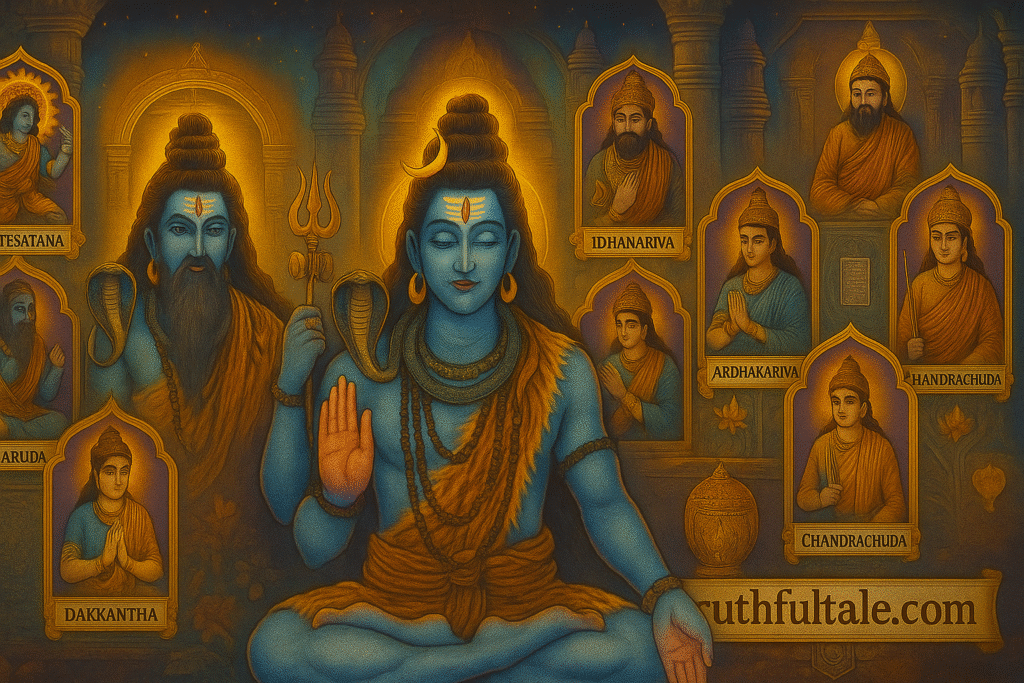🔱 How Many Avatars of Lord Shiva?
Exploring the Divine Forms of the Mahadev
Lord Shiva, one of the Trimurti (Trinity) in Hinduism along with Brahma and Vishnu, is known as the destroyer and transformer. While Lord Vishnu is widely known for his 10 Dashavatars (like Rama, Krishna, etc.), many people wonder — how many avatars does Lord Shiva have?
Let’s explore the avatars (divine forms) of Lord Shiva mentioned in various scriptures, their stories, and their spiritual significance.

📚 Historical & Scriptural Background
Unlike Lord Vishnu’s 10 well-defined avatars, Shiva’s incarnations are not limited or counted strictly. However, Shiva Purana, Linga Purana, and other texts mention several powerful avatars of Shiva, taken to uphold dharma, destroy evil, and guide the world.
The Shiva Purana talks about 28 main avatars, but 11 avatars are most popularly known as Ekadasha Rudras.
Let’s explore the most significant ones below 👇
🌟 1. Veerabhadra – The Warrior Avatar
Story:
Born from Shiva’s wrath when Sati (his wife) immolated herself at Daksha’s Yajna. Veerabhadra destroyed Daksha’s sacrifice and punished the arrogant gods.
Meaning: Represents anger for justice.
🌟 2. Bhairava – The Fierce Protector
Story:
Bhairava was born from Shiva’s third eye to punish Lord Brahma’s ego. He later became the guardian of temples and protector from evil forces.
Meaning: Destroyer of pride and guardian of righteousness.
🌟 3. Piplaad – The Healer Sage
Story:
Born to Sage Dadhichi, Piplaad cursed the planet Shani (Saturn) for his father’s early death. He later forgave him.
Meaning: Teaches forgiveness and healing from suffering.
🌟 4. Nandi – Devotee Turned Avatar
Story:
Nandi is not only Shiva’s mount (vahana) but is also considered an avatar of Shiva himself. He was born from a yajna and blessed with divine strength and knowledge.
Meaning: Represents devotion and service.
🌟 5. Ashwatthama – The Immortal Warrior
Story:
Son of Guru Dronacharya, Ashwatthama was blessed by Shiva with immortality. Some believe he is a partial incarnation of Shiva sent to participate in the Mahabharata.
Meaning: Karma, punishment, and living through time.
🌟 6. Yatinath – The Sage Who Taught Compassion
Story:
In this avatar, Shiva took the form of a hermit to teach a cruel king the value of kindness and non-violence.
Meaning: Represents transformation through wisdom.
🌟 7. Hanuman – Shiva’s Monkey Avatar
Story:
Yes! Hanuman, the devoted servant of Lord Rama, is believed to be a form of Shiva (Rudra avatar). He was born to Anjana and Vayu with Shiva’s blessings.
Meaning: Devotion, strength, and humility.
🌟 8. Rishabha (Adiyogi) – The First Yogi
Story:
As Rishabha, Shiva taught Yoga and meditation to sages. This form is also known as Adiyogi, the original teacher of Yogic science.
Meaning: Spiritual discipline and awakening.
🌟 9. Sharabha – The Beast Who Tamed Narasimha
Story:
When Vishnu took Narasimha form and couldn’t calm down, Shiva took the form of Sharabha (half-lion, half-bird) to pacify him.
Meaning: Supreme control over even divine anger.
🌟 10. Durvasa – The Angry Sage
Story:
Sage Durvasa, known for his quick temper and powerful curses, is believed to be a part-avatar of Lord Shiva.
Meaning: Represents balance of anger and justice.
🌟 11. Grihapati – The Devotee Avatar
Story:
A young boy named Grihapati worshipped Shiva despite obstacles. Shiva appeared as fire and blessed him, even protecting him from Indra’s anger.
Meaning: Faith and devotion never go unanswered.
Other Notable Forms of Shiva
- Ardhanarishvara – Half man, half woman form (Shiva + Parvati)
- Harihara – Fusion of Vishnu and Shiva
- Lingodbhava – Manifestation of infinite divine light
- Kalabhairava – Guardian of Time
- Mrityunjaya – Conqueror of death
🔮 Are These Avatars Still Active Today?
Many believe that these forms still influence the world, guiding devotees in mysterious ways. Some, like Hanuman and Ashwatthama, are even believed to be immortal and still walking the earth.
🙏 Conclusion
While Lord Shiva does not follow a strict pattern of incarnations like Lord Vishnu, his avatars are deep, mystical, and powerful. Each one reflects a different aspect of cosmic truth — anger, peace, wisdom, protection, or devotion.
✨ He is not just the destroyer of the world, but also the destroyer of ego, fear, and illusion.
🔖 Thank you for reading!
If you enjoyed this blog, keep visiting truthfultale.com for more such divine stories.
